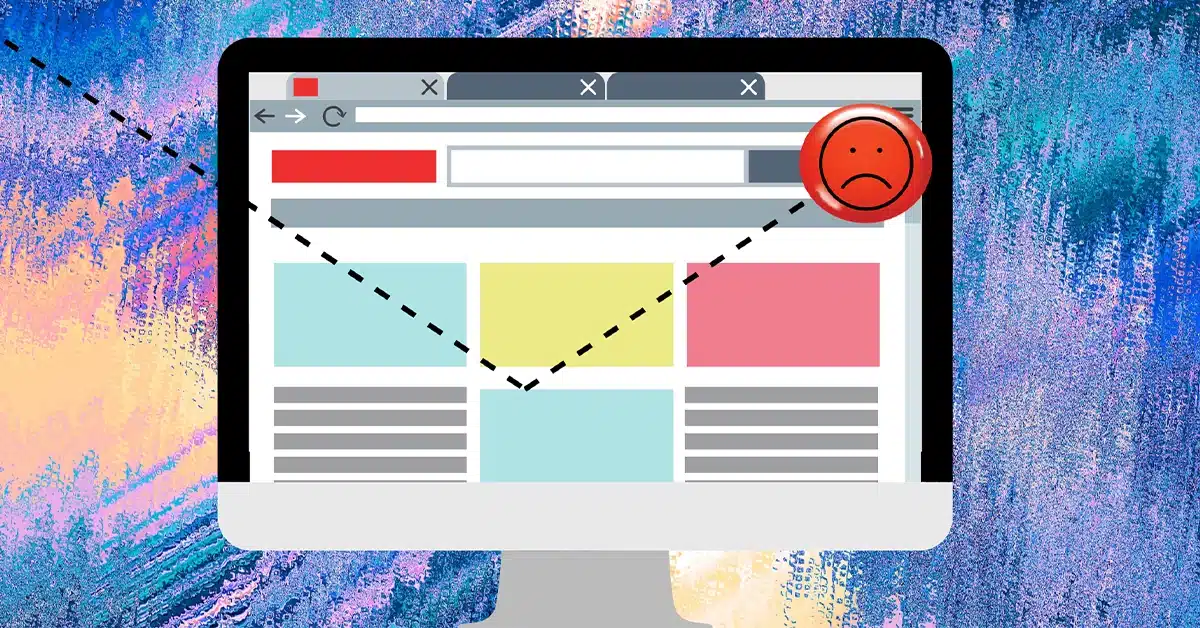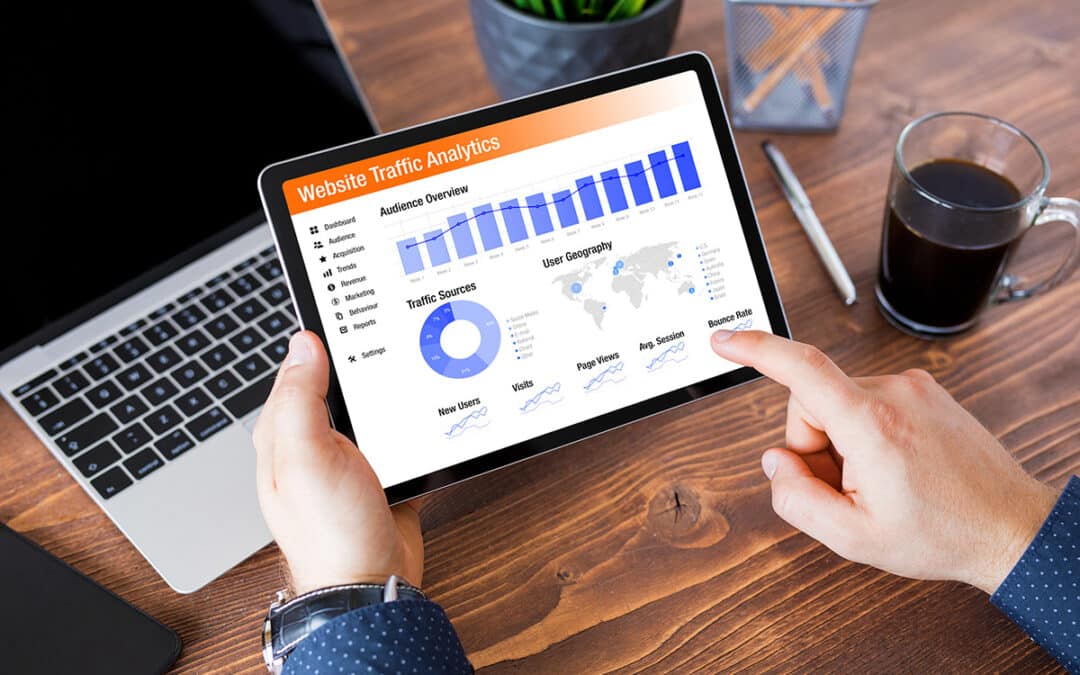Bounce rate: too low, too high, or just right? Even after dedicating hours to developing your website and optimizing your content, site analytics may still reveal that your pages are sitting at an uncomfortably high—or low—bounce rate. Before dissecting your onsite SEO to reach that “just right” bounce rate, take a look at the dynamics of bounce rates along with industry averages for the different pages on your site.
First Things First, What is a Bounce Rate?
Chances are, some of the essential marketing KPIs for your website include the bounce rate for various pages. Yet, you still might be unsure about what “bounce rate” actually means and how it affects your site’s performance. Generally speaking, a “bounce” occurs when a user visits your website and leaves without interacting any further. “Bounce” means that whether they choose not to click that “Learn More” link or fail to peruse your navigation bar, they leave or “bounce” from your site without taking any additional action.
A website’s average bounce rate displays the percentage of total site visitors who bounced off a single page without further navigating. This percentage is calculated by dividing the total number of single-page views by the total website sessions. So, any user who views just one page and closes out of your website will negatively impact your bounce rate. Under the Google Analytics rule, website visitors will need to click on at least one additional page to contribute to a lower bounce rate.

What’s the Average Bounce Rate for Specific Kinds of Pages?
When looking at Google Analytics, it can be tempting to compare your average bounce rate to other sites (namely your competitors). While average bounce rates vary dramatically between industry type and user intent, consider these averages as a steady benchmark for improvements.
Homepage Bounce Rate
As the face of your website, your homepage should provide users with a clear definition of the problems you solve for consumers, your specific products or services, and the directions users should follow to learn more. Typically, this direction can be in the form of a simple “Learn More” button or a robust navigation bar on your site’s header. Either way, this direction helps encourage users further down the funnel, helping them navigate the site and lower your average bounce rate.
According to Semrush, 41 to 55% is considered the average bounce rate for a website. Landing pages, on the other hand, tend to sit significantly higher at 70 to 90%. But bear in mind, your homepage might not act like your typical landing page. Instead, you may have dedicated landing pages for specific social ads or email newsletters. That being said, the average bounce rate of a homepage tends to vary dramatically depending on the particular industry, user intent, and whether traffic is funneled to the homepage or elsewhere.
Product or Service Page Bounce Rate
Service pages tend to have a more specific user-intent, as in, “I need this type of service, and I’m willing to pay this much.” So it makes sense that service sites tend to have a reasonably low bounce rate of 20 to 30%. This lower average is attributed to the fact that users seeking a service tend to have a more established understanding of what they’re looking for and are motivated to click onwards to learn more.
On the other hand, retail sites and product-specific pages tend to have a slightly higher average bounce rate of 20 to 40%. When working with eCommerce-based sites, you run the risk of users virtually “window shopping” and searching with less specific intent. Retail users will also often bounce between competitor sites to look for the best selection, price, and other factors that score them the best deal.
Blog Bounce Rates
When addressing average bounce rates for blog pages, expect to see some relatively high percentages. According to Ezoic, blogs can have an average bounce rate of 70 to 98%—yes, that high! While those averages can come as quite a surprise, the reasoning behind them isn’t always all that negative.
More often than not, well-written blogs will satisfy a user’s search intent, causing them to bounce from that page after you’ve answered their question. Similarly, many readers land on blog pages from social media links and return to their social platform after reading. These are just some of the many reasons you need to monitor a user’s time on the page, not only their bounce rate, to gauge your content’s success accurately.
Bear in mind, even with thoughtful internal links or enticing buttons to help guide users to other areas of your site, blog pages may still seem to not budge from those relatively high bounce rates. One of the best actions you can take is implementing clear calls to action (CTAs) throughout your site. Whether your CTAs direct users to related service offerings or just other informative reads on your site, a clear CTA can help bring those high bounce rate averages down by giving readers a logical page to visit next.

Understanding Mobile vs. Desktop Bounce Rates
Just as bounce rates vary from page type to page type, how users access your web pages will also impact your average bounce rate. Between the rise of social media disseminating content and the upsurge of users searching on mobile devices, it’s imperative to format your media for both mobile and desktop users.
Mobile Bounce Rate
According to recent statistics, nearly 60% of all internet searches are completed on a mobile device, with some sectors—such as food and beverage—reaching a whopping 72%. As more users rely on mobile access, you must consider how your mobile UX experience contributes to your average bounce rates. You should be readily optimizing your content—including images, loading times, and even burger-style navigation menus—to perform well on mobile.
On a day-to-day basis, mobile users are more likely to bounce from website to website. Not to mention, the growing influence of social media provides users with direct links to websites where they can quickly ingest content and bounce back to their social feed. For websites with a large influx of mobile traffic, you should expect roughly 10 to 20% higher bounce rates than desktop users.
Desktop Bounce Rate
Where mobile users tend not to have a specific intent and instead bounce between websites, desktop viewers will often search with more specific intent. Desktop users are also more willing to put in the effort to read and research, even if that means clicking through a tab or two. With this willingness to dive a bit deeper into the information they desire, desktop users will often click through a webpage to discover the in-depth information they’re seeking. Fortunately, the lower bounce rate frequency for desktop users can help even out the higher bounce rate of mobile users.
Different Kinds of Bounce Rates: The Good, the Bad, and the Ugly
Defining a “bad” bounce rate will always rely on a collection of variables, including device type, traffic source, website type, and especially industry type. For instance, a “bad” bounce rate for a service-based plumbing website may translate into a “good” average bounce rate for an e-commerce site. Bounce rate can even vary between e-commerce sites, with grocery retailers experiencing a 52% bounce rate and apparel retailers boasting a lower bounce rate of 42%.
Not to mention, sometimes an average bounce rate can be so low it’s considered bad. Often these “too good to be true” percentages are caused by technical issues with your website. Most commonly, bounce rate errors can occur on websites that input duplicate analytic codes into both the site’s header and footer. This duplicate code will confuse Google Analytics, causing your bounce rate to appear abnormally low.
For “bad” bounce rates that are too high, the reasoning boils down to users not sticking around on your website. This phenomenon can stem from many reasons, such as visually unappealing landing pages, extensive loading times, lengthy and wordy pages, or incoming traffic not correlating with the consumer group you are targeting.

How to Fix a Disappointing Bounce Rate
Before you can fix a disappointing bounce rate, you need to understand where the issue is occurring. Take a look at which pages of your website hold the highest exit volume, as these will be the pages users are abandoning most. Then, review the time spent on the page to see if readers are engaging at all with the content or if it’s a stone-cold bounce. Pages with little time spent but ultra-high bounce rates will take priority for updates.
Once you identify your troublesome pages, implement these changes.
Match Your Keywords to User Intent
It’s crucial to remember that various keywords hold a higher value than others. Your on-page SEO is heavily important, as keywords will vary depending on your business and user intent. These keywords can work to drive traffic to a page to help establish authority and convert readers into buyers—but when used with no regard to the user intent, misplaced keywords will instantly bounce users off your site.
If you choose specific keywords to drive individuals to your website, you must follow through with your promise to deliver the appropriate content. Be sure to use keyword variations and always bear in mind the user intent: What do they anticipate reading? What questions can you answer, or what information can you provide? Ensure that any page with a high bounce rate is accurately answering these questions.
Upgrade the Mobile User Experience
As more users continue to access webpages from mobile devices, Google Analytics has begun prioritizing mobile metrics. To effectively reach both mobile and desktop users, your website must be optimized for both forms of traffic. Although you may believe that your desktop format is beyond immaculate, if the page load time lags on mobile, you’ll quickly lose your users as they exit to search for the next best competitor.
Be sure to upgrade the mobile user experience to include:
- Less clutter
- Clear, legible text
- Easy to click links
- A streamlined navigation menu
- Shorter load times per page
- Optimized imagery or visual elements that won’t slow the load time
Improve, Analyze, and Repeat
After updating your keywords to match user intent and improving UX details like your page load speed, you’ll want to assess website performance. Tools such as Google Speed Test are an excellent way to check page load times to understand better where you stand before and after adjustments. Also, don’t stop with just backend adjustments. Remember to clean up cluttered pages and break large chunks of content into more bite-sized pieces, as dense pages can quickly scare off users.
As with all other marketing KPIs, reducing your average bounce rate requires time and testing to reach optimal results. Try incorporating A/B testing to see which of your adjustments perform better among your target audience. Improve, analyze, and fine-tune when necessary.
Don’t Let a High Average Bounce Rate Slow You Down
At Bullseye Strategy, we understand how frustrating high bounce rates can be for you and your business. Sometimes it feels as though all the organic marketing in the world isn’t enough to keep readers on your site. Fortunately, a combination of technical SEO, offsite SEO, and onsite SEO alongside an improved user interface (UI) for both mobile and desktop can help bring that bounce rate into a comfortable range. Contact us today to learn more about how we can help with your digital marketing efforts.








